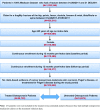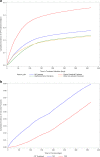Examining the treatment gap and risk of subsequent fractures among females with a fragility fracture in the US Medicare population
- PMID: 28536737
- PMCID: PMC5524851
- DOI: 10.1007/s00198-017-4072-6
Examining the treatment gap and risk of subsequent fractures among females with a fragility fracture in the US Medicare population
Abstract
Our aim was to evaluate the gap in osteoporosis treatment and the impact of osteoporosis treatment on subsequent fragility fractures. We found osteoporosis medication use lowered risk of subsequent fractures by 21% and that black race, higher CCI scores, dementia, and kidney diseases reduced the likelihood of osteoporosis medication use.
Introduction: The goal of this study was to evaluate the predictors of osteoporosis medication use and compare the risk of fragility fractures within 1 year of a fragility fracture between osteoporosis treated and untreated women.
Methods: We conducted a retrospective, observational cohort study using the national Medicare database. Elderly women (≥65 years) who were hospitalized or had an outpatient/ER service for fragility fracture between January 1, 2011 and December 31, 2011 were included. The outcomes of interest were the correlates of and time-to-osteoporosis medication use and risk of a subsequent fracture within 12 months for treated and untreated women. Cox regression was used to evaluate the predictors of treatment use and the risk of fracture based on treatment status.
Results: Women (28,722) (27.7%) were treated with osteoporosis medication within 12 months of index fracture, and 74,979 (72.2%) were untreated. A number of patient characteristics were associated with a reduced likelihood of osteoporosis medication use, including black race, higher Charlson comorbidity index scores, presence of dementia, and kidney diseases in the baseline. The predictor most strongly and positively associated with osteoporosis medication use after fracture was osteoporosis medication use before fragility fracture (HR = 7.87; 95% CI 7.67-8.07). After adjusting for baseline characteristics, osteoporosis medication use lowered the risk of subsequent fractures by 21% (HR = 0.79, 95% CI 0.75-0.83) over 12 months compared to women without treatment.
Conclusions: Demographics and clinical characteristics were strong predictors of osteoporosis medication use. In the US Medicare population, osteoporosis treatment significantly reduced the risk of fragility fractures.
Keywords: Fracture risk assessment; Osteoporosis; Therapeutics.
Conflict of interest statement
L. Xie, A. Keshishian and O. Baser are employees of STATinMED Research, a paid consultant to Eli Lilly Inc. in connection with the study design, data analysis, and development of this manuscript.
N. Boytsov, R. Burge, K. Krohn, L. Lombard, and X. Zhang are employees and stock owners of Eli Lilly and Co.
Funding for this research was provided by Eli Lilly and Co.
Figures
References
-
- Kanis JA (2007) WHO technical report. Report. University of Sheffield. https://www.shef.ac.uk/FRAX/pdfs/WHO_Technical_Report.pdf. Accessed 28 March 2017
-
- Agency for Healthcare Research and Quality (2011) Healthcare cost and utilization project. HCUP Central Distributor. https://www.hcup-us.ahrq.gov/db/nation/nis/NIS_Introduction_2011.pdf. Updated November 2015; Accessed 28 March 2017
MeSH terms
Substances
LinkOut - more resources
Full Text Sources
Other Literature Sources
Medical
Molecular Biology Databases
Miscellaneous



